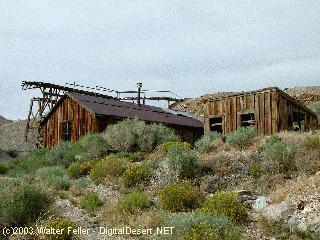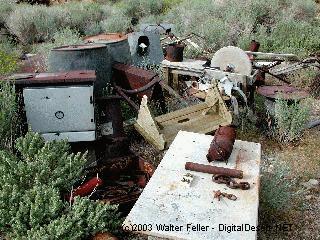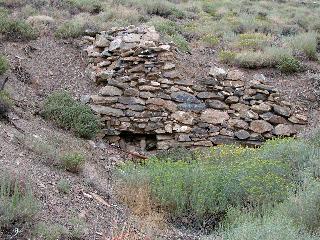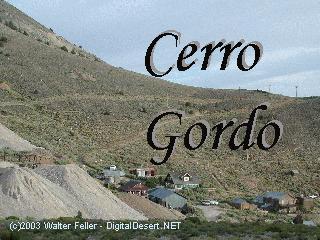Cerro Gordo
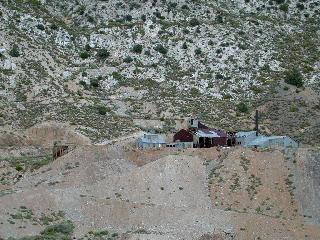
Wandering prospectors from the Coso area were responsible for the discovery and early development of Cerro Gordo. In 1865, Pablo Flores discovered rich silver float at the foot of Buena Vista Peak in the
Inyo Mountains. He
and his friends later located the Ygnacio, San Francisco and San Felipe mines. Their efforts were limited, having no capital to invest except their own labor. Ore was smelted in crude "vaso" furnaces.
A man named Ochoa developed his San Lucas Mine, becoming the first to make a committed effort to establish mining at Cerro Gordo. The San Lucas Mine treated its ore at the Silver Sprout mill, several miles west of
Fort Independence. The
Lone Pine Mining District (including
Cerro Gordo)
was formed on April 5, 1866. The first claim was the Jesus Maria. By the end of 1869, over 900 locations had been filed.
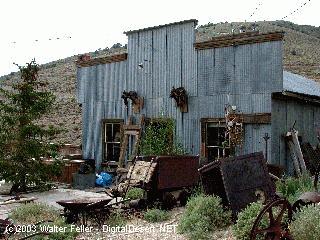
A prospector, who in May, 1867, displayed Cerro Gordo ore samples in Virginia City, Nevada, is credited with bringing Cerro Gordo into the public's eye. One of the first persons to arrive in Cerro Gordo after this was
Mortimer W. Belshaw, a mining
engineer from San Francisco. Six years earlier, Belshaw was working mines in Sinaloa, Mexico and while there became knowledgeable in the silver smelting process. He arrived at Cerro Gordo in April, 1868.
Recognizing Cerro Gordo's potential, Belshaw set out to control the whole hill. As lead ore was needed to smelt the silver ores, Belshaw obtained a one-third interest in the Union Mine on May 6, 1868. He obtained his one-third interest by ingeniously promising the Union owner, Joaquin Almada, one-fifth interest in a smelter yet to be constructed.

He extracted several tons of ore from his new mine, smelting it down in "vaso" furnaces, and went to Los Angeles and then on to San Francisco to secure financial backing. Belshaw and Egbert Judson, president of California Paper Company, formed the Union Mines Company. Belshaw returned to Cerro Gordo with A. B. Elder, his mining companion from his Mexico days. The two began a systematic development of the hill that was soon to be theirs.
In July, 1868, Belshaw graded a steep and winding eight-mile-tong toll road, charging a dollar for wagons and twenty-five cents for a horse and rider. The toll road finished, Belshaw started hauling in the machinery for his second project, a smelter that was going to produce an unheard-of four tons of bullion a day.
His "Belshaw water jacket" invention proved to be so efficient that soon after having first fired up his blast furnance in September, 1868, the output rose to five tons of bullion per day. Regular ore shipments to San Francisco via Los Angeles began on December I, 1868, with each trip from
Cerro Gordo
to Los Angeles taking a month. The steamer Orizaba shipped the ore in three days to San Francisco, where Thomas H. Selby smelted it further, sending the silver to the United States Mint.
The opening of Belshaw's smelter caused the population at Cerro Gordo to swell from 200 to 700, as people began pouring into the "four-dollar camp." In 1869 Cerro Gordo began to boom, and by 1870 it had stage service with Independence and, a year later, with Nevada, San Francisco, and Los Angeles.
Victor Beaudry,
who came to Cerro Gordo in 1866 as a merchant, built a blast furnace in 1870 patterned after Belshaw's. This increased Cerro Gordo's bullion output to nine tons a day. Beaudry acquired many valuable mining claims by extending credit to miners with whom he did business, including a one-half interest in the Union Mine. By 1870 Belshaw owned one-half of the Union as well, and the two went into partnership.
Belshaw and Beaudry charged $50 a ton for reducing ore at their furnaces. The ore needed to have a silver value of $100 per ton or higher in order to turn a profit. All of the silver mines worked during 1872-1874 had become indebted to the furnaces on the sale of ores, and many, if not all, had closed down. This left Belshaw and Beaudry in control of the whole hill.
The payroll at the Beaudry furnace, where 25 men worked, was over $3,000 a month. The furnace also consumed $750 in water and $7,800 worth of charcoal a month. It took 8 tons of charcoal to smelt 25 tons of galena sulphate and carbonate lead ores.
Few timbers were used in the Union Mine, causing frequent accidents for the 20 underground miners, but by 1876, these men were raising 60 tons of ore a day from the mines. The ore was brought to the surface with the help of a 16 horsepower engine where it was loaded into wagons for the 150-yard trip to the furnaces. A little under one million dollars was produced by the district in 1872, and two years later the district produced over one million dollars in silver and more than one-half million dollars in lead.
Freighting at Cerro Gordo
Remi Nadeau received the contract to haul Cerro Gordo's bullion, and had begun work by December 1868. In 1870, with 32 teams, Nadeau agreed to haul 130 tons a month, which was only half of the capacity of the furnaces. Wagons would start out on the 200-mile, 3 week trip by chaining their wheels in place for the ride down Yellow Grade.Practically every day, $50,000 worth of Cerro Gordo silver and lead were hauled by Nadeau's company into the streets of Los Angeles. Three hundred and forty tons of bullion were hauled from December 1868 to the end of 1869. The amount doubled to 700 tons in 1870.
Nadeau's contract with Belshaw expired December I, 1871 and was taken up by James Brady, who in 1869 came into Inyo County as superintendent of the Owen's Lake Silver-Lead Company. Brady founded the town of Swansea, some three miles north of Keeler, and built a furnace there to work Cerro Gordo's ores. In an effort to save expenses, Brady built a small steamer 85 feet long, It was launched June 27, 1872, and by churning across Owen's Lake, it cut a few days off the 3 week trip to Los Angeles. Christened the Bessie Brady after his daughter on July 4, 1872, it carried 70 tons of bullion a day across Owens Lake. This only transferred the pile of bullion from Swansea to Cartago, where wagons still couldn't haul it away fast enough.
That fall, rains hampered freight teams, causing 12,000 bars of bullion to accumulate at Cartago, and 6,000 each at Swansea and Cerro Gordo. The bars became building blocks as creative citizens constructed rooms out of them with canvas roofs. In March, 1873, a disease effecting horses was widespread in Inyo County. It subsided in April, but not without causing even greater freighting complications. By May the pile of bullion had grown to 30,000 bars, and Belshaw and Beaudry were desperate.
Finding Nadeau finishing up a Nevada contract, they approached him in hopes that he would once again accept the contract. He agreed only if Belshaw and Beaudry joined him in forming the Cerro Gordo Freighting Company and were willing to spend $150,000 in establishing a line of stations a day's journey apart. With all three accepting the conditions, Nadeau was, on June 6, 1873, once again in Los Angeles with a load of Cerro Gordo's bullion.
By late fall of 1873, the teams were catching up with the backlog. Belshaw did some furnace remodeling, shutting down his furnaces and thus allowing the freighters even more time to catch up. In 1874, with bigger furnaces, the two mills produced a total of 400 bars a day, twice the output of 1871.
Mines needed lumber for fuel and mine timbers, and the wood supplies on Inyo Mountain were getting scarce by 1873. A Colonel Stevens proposed constructing a mill high in Cottonwood Canyon, west of Owens Lake, with a flume six miles long running down the canyon to the wagon road. His mill began operation in 1873, the flume being completed in the spring of 1874. The mill tapped a resource of many square miles of scrubby forest which, during the winter, was out of reach due to deep snows.
In 1870 an attempt by Belshaw to pipe water into Cerro Gordo only resulted in a tot of frozen and broken pipelines. Three years later Stephen Boushey's Cerro Gordo Water and Mining Company began construction of a pipeline and a steam pumping plant which brought water to Cerro Gordo from Miller Spring, 10 1/2 miles northwest of town.
From the summit, the water ran through 13 1/2 miles of 4 inch pipe, falling 950 feet into town. The pipeline was 4 1/2 miles longer than originally planned, as a certain section of the pipeline crossing a valley could not withstand the pressure. At that point, all the water leaked out of the joints. The engineer tried unsuccessfully to seal the joints with lead, then tore up the pipe and ran it around the mountain. This added $26,000 to the cost of the pipeline, making the cost of the whole venture in excess of $74,000. With the line completed in May, 1874, water that previously cost 7 to 10 cents per gallon sold for 1 1/2 to 4 cents. It delivered to town only two-thirds of the water that passed through the pumping plant.
The Union-San Felipe conflict
Mr. John Simpson was hired by Belshaw and Beaudry in 1874 to construct a 4,000-foot tunnel under the town of Cerro Gordo to tap the Union vein and provide easier access. Whie in their employ, Simpson refused to pay the high toll price of the Belshaw-controlled road up Yellow Grade. With public opinion in his favor, Simpson was successful in getting the Inyo County Board of Supervisors to reduce the toll charges. This action greatly favored the Owens Lake Silver-Lead Company who used the road to transport ore to their smelters in Swansea.The two biggest mines in the district during the 1870s were the Union, owned by Belshaw and Beaudry, and thee San Felipe, or Omega (located adjacent to the Union) owned by the Owens Lake Silver-Lead Company. This company brought suit in 1873 against the Union Mine and Belshaw's company to force a point. The Owens Lake Silver-Lead Company was driving a tunnel to intersect its silver vein when they struck lead. Belshaw, upon seeing galena on the San Felipe dump, accused the Owens Lake Silver-Lead Company of robbing his mine (vein) and boldly took over the San Felipe tunnel. The Owens Lake Silver-Lead Company was suing for damages and to regain control.
In a weeklong trial in July of 1873, it was claimed by the Owens Lake Silver-Lead Company that the Union Mine was claim-jumped by its original locators, it being a part of the San Felipe vein. The Union group contended that the San Felipe was a silver vein mine cutting diagonally across a lead vein. The jury thought the San Felipe discovers shafts intersected the two veins, and the Owens Lake Silver-Lead Company won.
While the verdict was being appealed, the Union group was "vigorously at work robbing the mine of the rich ores, leaving all ores assaying less than twenty- five percent lead in the mine or putting them over the dump as waste." In May, 1875 Belshaw obtained a new trial which dragged on for a year. The Union Consolidated Company was finally formed in 1876 as a compromise to both groups.
When both furnaces in Cerro Gordo and the other furnace at Swansea were in full operation, Cerro Gordo boasted a population of 500 to 600 men working as miners, furnacemen, coal burners, and packers. In December 1876 the Belshaw furnace had shut down. By 1877 only 60 people were employed. The Union works burned down on August 14, 1877, causing $40,000 worth of damage.
By October the Union was repaired, but Belshaw reported to his company directors in San Francisco an indebtedness of $110,000. Beaudry resigned his position in the company and left for Darwin. Miners' wages were reduced to $3 a day in March, 1878, and half of them immediately left town. The next month the last stage pulled out of Cerro Gordo. The Union Mine was abandoned in October, 1879, and on November 20, 1879 Beaudry's furnace closed down. Remi Nadeau hauled the last load of 208 bars of bullion and a 420-pound mass of silver on November 21, 1879. In June, 1882,the Bessie Brady was destroyed by fire.
In 1911 Louis P. Gordon discovered zinc in the Cerro Gordo properties and worked the mines again from 1911 to September 15, 1915. A six mile gravity-powered tram was built in 1911 at a cost of $250,000. The mines also saw intermittent production from various owners from 1923-1933. From June, 1929, to April, 1933,the American Smelting and Refining Company obtained 10,000 tons of ore worth more than $300,000. The Cerro Gordo properties were briefly worked during World War II by the Golden Queen Mining Company. With 30 miles of underground workings, Cerro Gordo produced an estimated $17,000,000.
